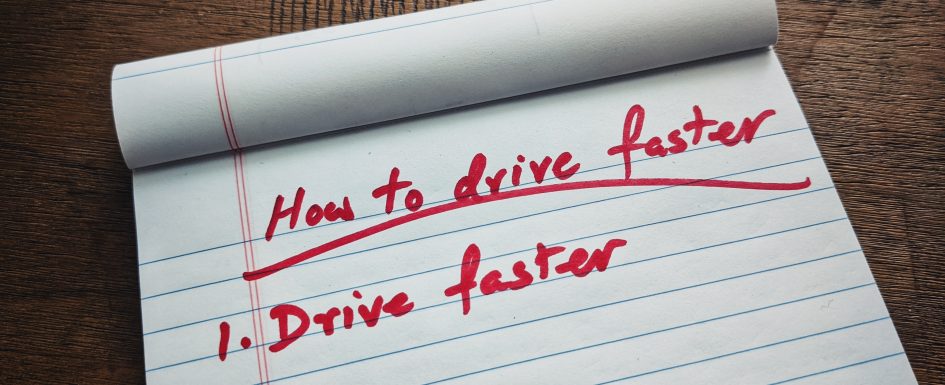While it sucks that most of us are stuck at home right now unable to participate in motorsports activities, we can choose to use the time productively and get better prepared to kick butt when racing activities pick back up. There are, of course, innumerable things we could be doing; we could work on our cars to make them faster, we could turn to sim racing, we could enroll in online courses, and so on.
But today, let’s focus on 2 specific things that anyone can do without spending a dime.
1. Review past performances
Take advantage of this down time to review your past performances, using video and/or data, with the goal of critically assessing your driving, and identifying specific areas for improvement. Review footage/data from multiple races and try to identify patterns. Do you make a habit of charging into corners too fast? Braking too late? Do you tend to lose time by being too aggressive on throttle? Or not carrying enough speed? Do you drive certain elements cautiously because of fear of spinning the car? Try to get as specific as you can!
Here is a previous post that discusses how to analyze your videos to find areas for improvement. If you are a student of The Complete Autocrosser’s Manual, review section E.4 about video and data analysis for a much more in depth take on this, and watch the 2 videos in section F to see walk-throughs of how to find areas for improvement from your videos.
For example, here are some things I notice for myself to work on: (1) At national events I tend to frequently cone or make big mistakes on my first 2 runs which puts pressure on me to deliver on the 3rd run. (2) Many of my mistakes (hitting cones or ending up out of place) are caused by charging into corners too fast. (3) I lose significant time by trying to be too aggressive/early with my throttle inputs, causing the car to slide.
The importance of having a specific list of things to work on cannot be overstated. It lets me come up with a plan that I can be confident will have a tangible and measurable impact on my performance.
Imagine that your significant other came up to you and said that they need you to be a better partner. Apart from being taken aback by the sudden and seemingly random request, most of us would probably want to know in WHAT ways they need us to be a better partner. Or imagine you have your performance review at work, and your boss only tells you that you need to “do better”. Again, I would imagine that most of us would want to know specifically WHAT we need to do better , how it will be measured, etc.
Most of us go to each autocross, HPDE, wheel to wheel race, or whatever, with the nebulous goal of “doing better”, with the blind hope that improvements will come magically over time. This is a fallacy we have all heard a billion times, expressed as “I just need more seat time” (disproven here). Sure, given enough time, we will make some improvements anyway, but we can significantly accelerate that process if we arm ourselves with the specific knowledge of what we need to improve, and make a plan for improving it.
2. Another way to identify hurdles
Take a moment to imagine this scenario…
If you are an autocrosser, imagine that you are on the starting line, about to begin your last run. If you are a wheel to wheel racer, imagine you are about to pass the start/finish line and see the white flag being waved as you begin your final lap. Imagine either of these scenarios as vividly as you can. Imagine the physical sensations, the sounds and smells, how you are feeling in the moment, what thoughts are going through your mind, etc.
Seriously, take a minute to imagine all the details. OK, do you picture it?
Now, what position are you in on the leaderboard?
A couple of years ago while doing research for a BeST article, I had an in-depth discussion with a sports/performance psychologist, and this is a minor adaptations of a mental exercise he had me go through that I had found really illuminating. For one, it is insightful to consider why we feel a certain way or have certain thoughts running through our heads as we begin our last lap. If we are nervous… why is that? If we are totally calm… why is that?
But the greatest insight comes from digging into what position we imagined ourselves in on the leaderboard. If we are not in the lead… why is that? Did we make mistakes on previous runs/laps? Is there someone more skilled than us in the position(s) ahead, and what skills do they have that we do not? Or… do we have a mental block that makes it hard for us to imagine ourselves in the lead?
This is a REALLY powerful tool to help identify what we need to work on, and the things limiting our performance are just as likely to be specific driving skills, race strategies, or mental hurdles that we need to overcome. Our psyche can help provide the answers! By considering what made us imagine ourselves in a non-winning position, we can clue ourselves into specific areas for improvement.
(SIDE NOTE: Whether we realize it or not, most of us carry around unspoken/subconscious self-limiting beliefs. How many of us have ever thoughts things like these… “I’ll never be as fast as xxxxxxxx”, “I’m not the kind of person who does xxxxxxxx”, “I’m too young/old”, “I always mess things up eventually”, etc.)

